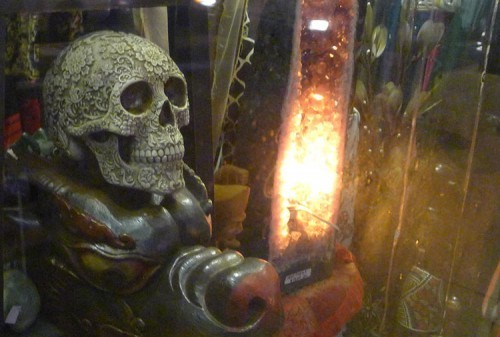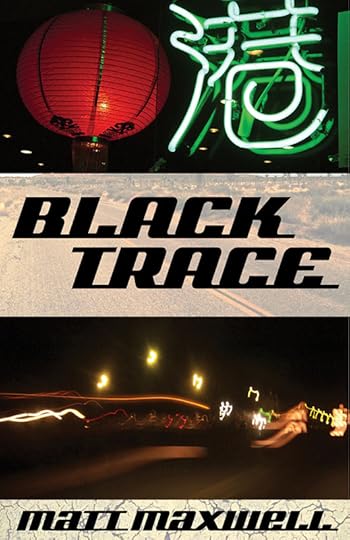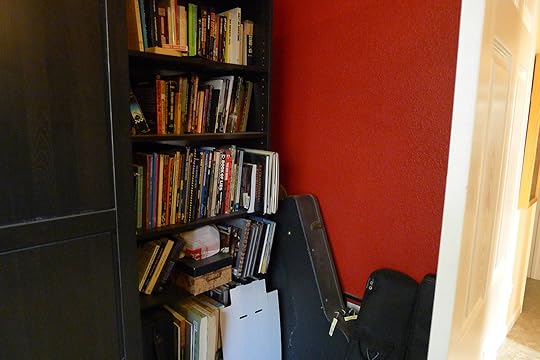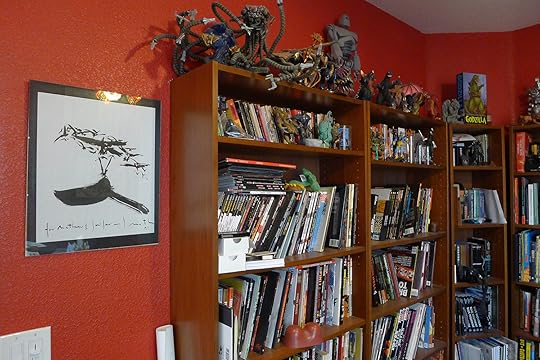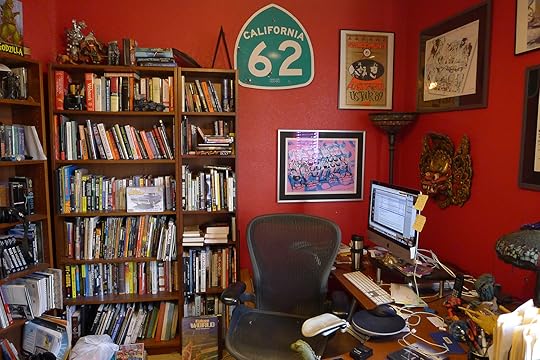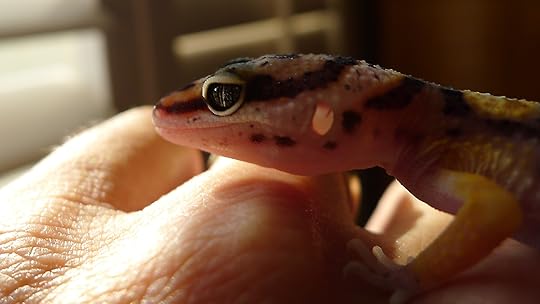Matt Maxwell's Blog: Highway 62 on Goodreads, page 29
October 31, 2014
EDGED – Full Bleed goes to the William Gibson show
EDGED
The last time I tried to attend a William Gibson signing was the day that my father-in-law decided to start punching out. I was about twenty miles from home when I got the call and turned around. Anyone who saw it as a surprise wanted to see it as a surprise. He was dead some two months later.
I’m positive that I never drove to the store to claim the book that I’d pre-ordered, now that I think about it. And my father-in-law is still around every time my wife thinks about him.
So going out this time felt like throwing a switch or completing a circuit. Or maybe it was just me kidding myself into thinking that retracing my footsteps was pushing into uncharted territory. But isn’t that just the process of rewriting?
Honestly, there aren’t too many authors/bands/etc that I’d go make the five-hour return trip for, even if just to listen to music and drive and not think about anything for half a day. Which is something I used to do a lot of, but then responsibility set in.
And while the sky over San Francisco wasn’t the color of a dead channel (not enough green), the fog was eating the city hard by the time I got there. Turns out that the only traffic I ran into was that of my provincial and remote Sacramento, no apparent reason behind it other than to exercise the clutch foot. But then having a stick-shift in San Francisco is a lot of fun if you’re the head of the line at the light or need to zip across Oak to beat oncoming traffic. Car’s got low-end if you get into second fast enough but not too fast. Stay in first too long and you better jump to third unless you like the grind.
The Haight (no I don’t go there usually—sticking more to Hayes Valley and the Sunset) is a lot like the longest line to get into a Jethro Tull concert you’ve ever been in. The street economy seems to be based on selling reefer and shrooms to outsiders and finding ways to scam into the bathroom at the Whole Foods. Though there’s excellent carnitas to be found at El Faro, which is right next to the Booksmith, where the signing was going on.
I lucked out and found parking right in front of the store, watching as a dented Prius nosed its way out. That should have been my first clue that there was no way my car was going to fit without making an insurance claim first. Still, I’m stubborn.
Burned up the next twenty minutes driving down too-tight streets, deciding not to park next to the McDonald’s where it looked like someone had been handing out pit bull puppies six months ago and everyone was coming back for a reunion, noses to tails all leashed by loops of rope that must have come from a hardware store. Found parking at ten of six and waited ’til then for it to magically stop being a tow-away zone, blasting “Turkish Leather” as the minutes ticked down.
Carnitas and Jarritos lime and fresh-fried tortilla chips with perfect salsa (go for the ‘hot’ – it’s okay, I promise) for dinner, watching LeBron thwarted in the first half against the Knicks. He’s got to get the game out of his head and just play it. Walk up and down Haight and feel like there’s way too many people in one place for this to be a good idea. Artisanal stained glass, Tibetan gifts, micro-fashion lines, vinyl toys both individually-marked and mass-produced franchise totems. And musical instruments. Lingering for a long time at the sealed Moog Sub 37 box. Never touched one. Would like to before I commit.
Watching a place try and maintain its reputation always is a little sad. Las Vegas does it with such gusto that I can’t help but admire it. Los Angeles is impassive, dragging its history behind it. The Haight doesn’t ever want anyone to forget 1967 (not that I can, but I was an original issue back then). And since I identify more with the music of the Velvets and the Stooges (though I’m west coast to the core), I can’t get behind the veneration. Especially the Dead, though I’d like to have heard a show through the Wall of Sound even if I’ve got no patience for their music.
Arrive at Booksmith in time to get a seat, which was a welcome surprise, given that their website said that seats were gone that morning (I checked – and the internet always lies.) Sit down, document, obsess. Think about how this should have been four years ago, wonder if those cuts will heal up right or if I should just avoid them altogether. Crack THE PERIPHERAL and admire the ease with which it comes off. I know it’s not easy, though. That’s another lie. That whole perfect draft. The myth of the accident. The accident can lead you down another path is all. Still have to put in the work.
Liking the parallel narratives and wondering exactly how they’re going to be bound together. Which is nice because I’m beta reading a thing which is trying the same thing and just isn’t working. Maybe it’s the lack of tension between the past/present that’s not working. Either way, THE PERIPHERAL is doing it in a way that does and I can already see a re-reading will be demanded (which lemme tell ya, doesn’t happen often.)
William Gibson is not yet Burroughs-gaunt, which comes off a little more Lovecraftian than I meant it to. I’m still delighted by the tension between the perception of his writing (particularly with the Sprawl trilogy) and his demeanor out in the real world. He’s not trying. He just is. Authenticity remains the best disguise.
Talk of spoilers, which is perhaps the singular post-internet contribution to the participation experience which nobody saw coming. Left me wondering about the co-evolution of the forms and delivery methods, particularly in serial entertainments. But then that’s what the broadcasters would want us focusing on, the singular experience of watching a thing as it happens. Yet AGRIPPA is cracked and posted before the livecast in 1994 or whatever year it was. The ultimate spoiler. Because someone could.
I may have to get THE PERIPHERAL on audio, if only to hear the emphasis that doesn’t always come out in the text, though I could see as flat a reading as possible working. But Mr. Gibson’s read, injecting more than a little bit of “Oh we’re fucked” mixed with ego-manipulation artist-brand-management was nice. Maybe the audiobook is all him and that would be fine.
Audience mix is odd. I’m not the oldest guy there, which is how it is when I go to concerts these days (though I think there was a guy older than me at the Earth show in September.) Older than the bands now. Mix of questions. Talk of multiple Cory Doctorows creating their own panverses by merely discussing them. Magazines as printed (and expensive) novelty-aggregators in the days before the firehose of novelty we call the internet (you know, 1992 and earlier). Reinforcement of the notion that science fiction is really about the time that it’s written in. Mulling over that thought as I looked at the science and sociology sections while I was in line and thinking that the temporality statement needs to be broader and how that would be a really unpopular thing for me to say. Oops.
A perhaps surprising thing he brings up is that he doesn’t read fiction when he’s writing. I feel like I shouldn’t discuss the reason why, even though he did in a relatively public moment. Though it’s more quasi-public, not livestreamed, so I’ll honor the moment and not spoil the surprise other than to say that it’s a feeling I’m all too accustomed-to. Though I’m not sure that sharing this personality tic is encouraging or depressing. I’ll try to see the half-full glass.
And remember that just because someone likes an author you like and went to a signing doesn’t mean that they’re a person you’ll want to be around, if the guys behind me in line were any indication. Walking talking snark with nothing genuine to say other than a grouch about having to get up for a meeting. Try harder, boys. There’s a whole big world out there if you’re willing to stick your neck out a little.
Line is moved briskly, forced by necessity. It snakes to the back of the store while Mr. Gibson is ushered to the front, fielding questions about a very particular anime statuette that may or may not have been presaged by his works, which is one of those questions that says more about the questioner than the recipient. I hold onto my copy of THE PERIPHERAL and STORMING THE REALITY STUDIO, now battered and nicked from more than twenty years. You may not know this, but I’m not good with humans out in the wild. Never particularly have been. Not comedy-level or anything, just an odd fit though I can pass as almost normal if you don’t squint too hard.
Mumble some words to Mr. Gibson about packing efficiency and how a twitter exchange triggered “Tug on the Ribbon” while I pass that and a book of my photographs (Los Angeles, as seen in 101 NORTHBOUND) over to him. He graciously accepts and feel like maybe I’m slowing the line down too much and reminded of my maladjustment.
Some circuits don’t close so easily, I guess. Glad to seal off those that I can, though.
Grabbed some available light and took a few pictures, just to remind myself that the story is everywhere. Where’d those boots come from? Who’s giving the practiced street kids all these pitbulls? When will 1967 end?
Haikai No Ku on the stereo through the mist and the drive over the bridge. The Art Deco one, not the sweep of white over the Bay like the spokes of a recycled plastic pennyfarthing tooling over the Great Pacific Garbage Patch. Eight cylinders throw a growl on the 101 as I drop to fourth and drop up a lane.
October 20, 2014
BLACK TRACE
BLACK TRACE, my first science fiction novel, is up in part over at Wattpad and WriteOn (probably in a few other places at well). Wattpad is just the easiest to link to. I plan on running the first several chapters, enough to give folks a sense of the story and the setting. I have no plans to put the whole thing on the internet, much less for free.
You’ll see me use the word “nopocalypse” in reference to this. More on that later.
Here’s the back cover copy, were it printed and had a back cover to put copy on:
—
After the Great Big Zero.
After the United States came untied.
Life went on.
Jake Culver is a driver, a fixer and an enigma. Out in the no man’s land of desert California, people don’t often ask what anyone did before or how they got there. But now the state police are asking him and he doesn’t have the luxury of refusing an answer.
Left no choice, he agrees to return to his old haunts in the manufactured paradise of Orange County. The Orange Trust runs it like a company town, which would be fine if Jake and the man at the top didn’t share the baddest of blood. Jake’s got only days to find out who’s stealing from the hotbed of high-tech, and to find if it’s the same someone who is trying to get the biggest criminal organizations in the county to pick a very public war with one another.
From the cracked asphalt and no rules motorized combat beyond the reach of authority to the regulated cool of the icehouse and back again, Jake and his reluctant partner Tommy Manh dig through the above-ground and underground of a decadent near-future California. The chase leads them both through the abandoned subway tunnels run by the electrified Mozarts and the subtle digitality of the Weave, to the neon playground of Fascination Street.
But all the paths Jake finds lead him back to his past, a past that is fast overtaking him.
October 7, 2014
Weaponized melancholy redux
Story changed. Mostly stopped changing enough so that I can start to get it out. Had to wrestle with this one for awhile, which is always upsetting when you think you have it nailed in the first place. There were lots of pieces but not a coherent whole, nor were the pieces enough to make it work.
More later.
September 25, 2014
“Weaponized Melancholy”
My two word reply to a tweet from Tim Maughan today. Which is now metastasizing into a piece of Ballardian science fiction. Long short story or short novella, depending on how you define those kinds of things. Not going to worry about it, but just let it be. Which is opposite to how I write novels because, man, if you don’t have a pretty good plan, you get in trouble in short order. Or rather, in long order and lots of work needs to get redone, and really, who wants to re-do a whole lot of work?
Keywords: Theosophy, Cloud, Qlippoth, Anxiety, Telepresence, Commercial, Freighter, Job-hunting, Journalism, Autism, Resource management, and yes, Weaponized Melancholy.
Should have a draft done about this time next week. That’s how these things have gone in the past and I’m hoping that I’m not too rusty.
Con-volution 2014
Just a head’s up that I’ll be a guest/panelist at Con-volution 2014, repeating my role as such from the 2013 show (also the first SF show that I had the pleasure of being a guest of, even if was late to my first panel.) The show is at the Hyatt Burlingame, which is a nicely Ballardian facility, kinda LOGAN’S RUN city of the future enclosed tropical paradise on the fringes of the chilly south San Francisco bay.
I’ll be on three panels Saturday and at a reading on Friday. I had planned on being there Sunday but my plans have changed and I’ll be back home Saturday night. Here’s the schedule:
Friday – Reading, 4pm: Not sure what I’ll read. Maybe a bit from BLUE HIGHWAY since I just finished that.
Saturday 10-2: How To style publishing panel. In my case, I’ll be telling you all what *not* to do, ’cause that’s what I did.
Saturday 12-2: Merging Genres panel. Which should be good given my well-known love of working between genres or turning them inside out when the mood strikes me. Honestly, genres are there to help booksellers and reinforce preconceptions, not to do anything for the reader. So yeah, this should make me some friends.
Saturday 4-6: Comics to Film, where I’ll talk about how ROBOCOP and DREDD are the greatest comic adaptation films out there. I expect to make lots of new friends.
Look forward to seeing any/all of you there. I’ll sign whatever you put in front of me and even have paperback copies of things for sale (maybe even the very hard to find saddle-stitched print version of “Tug on the Ribbon” which will never be printed again, so collectors take note.)
September 23, 2014
October is coming
No secret that autumn is my favorite time of year. Plenty of reasons for it. Mostly because the heat of summer (much more prevalent in the Sacramento area than in my native Southern California) bleeds out. And you get the tilting of the light and dusk that goes on forever. Then there’s the sense of renewal, of everything beginning to shut down for rebirth later. I’ve always liked the preparation for spring more than spring itself. Not sure that makes a lot of sense. Just the way I’m wired. But then I like music that most people wouldn’t recognize as such.
Hoping that autumn brings some renewal around here. Sure could use a bit of that.
September 17, 2014
Dictionary training
So here’s what I had to teach to my user dictionary over the course of writing BLUE HIGHWAY. Apparently I break the rules, according to Microsoft. Some of these are understandable. Some are just baffling.
westie
lunger
Torchco
gonna
gimme
I’ma
metalscape
junkers
Partch
sleepin’
wanna
DeSoto
Bolsa
Edinger
lightcloud
clipshow
gearhead
Edelbrock
nastygrams
pinche
Criver
bish
dy
godda
backglass
Twentynine
MexPet
Almo
bitcaster
blanco
cuerpo
Bustout
jaggies
jaypeg
yo
lino
RegServ
lotta
minigun
sorta
Custers
blueboy
buzzbomb
Necros
Kalash
oughta
kipple
starshell
freshies
muchas
streetsweeper
pics
pushouts
Bashour
punji
glitched
federalana
rebs
Ridgways
Prell
swole
goddamit
chaingun
slatescreen
workpad
precycle
fabbed
looey
vampiric
Nubucks
muerte
Buzzsaws
Streich
fléchettes
Everguard
melta
killbox
rattery
NorCal
LiSP
copylocks
lamé
nots
jefes
supercons
railguns
diamonder
infoforensics
scroller
curlies
prybar
Manh
onboards
whaddya
y’know
empeñadas
strobing
citylets
Edsel
yous
Gorgonios
unreadability
shrinkwrap
Heatengine
Khmeresque
heavybeat
Dalcheen
Najafi
Incrim
dunno
kinda
‘zine
scummed
skyrise
infosecurity
wanna
undernet
giallo
feelin’
porosil
lockgroove
volted
Solarczyk
neurocyb
neurocybernetics
datawall
huevos
partygirl
buzzkill
greysuit
slagged
scissored
dyin’
bullcrap
algos
poors
Mozarts
gaslamps
chiselings
Queheca
tubelight
mascara’d
OrComm
primefeed
mic
warpaint
kinda
Karman
sicky
flatlined
fuckin’
keepin’
Strad
possuming
weblike
Lyuapanov
codeswitch
datafloes
Brutalist
Fantastikas
stuccoed
thorned
freaktastic
datamass
uptop
roadkill
smokeout
Eiolodon
audioscape
Crustecorp
Sammystown
queso blanco
backgrounding
Santa Anas
slimline
Bayon
somethings
shoulda
datamanip
befores
freakshows
biolume
Candyland
newblood
cutscenes
plexi
shitbirds
handjob
mistless
buncha
heart’a
squarish
jammin’
goin’
carnitas
talkin’
Lotta
daywatch
changin’
Olufsen
fatfinger
laters
Carden
fuckface
roadtrip
deadman’s
plastique
gatlings
coulda
shitshow
underwings
whitescreened
getcha
glassman
September 16, 2014
Absolution in Draenor

Grom, the father
Heavy stuff, absolution. The undoing, or at least the forgiveness of sins. It’s a hard thing to come by. Redemption is a story driver that gets kicked around and lip service is played to it, but oftentimes, just that. I mean, video game characters get redemption through laying waste to countless multitudes of enemies and then often winning at best a pyrrhic victory as they bleed out in the last few seconds or stare meaningfully into the middle distance.
Absolution, however, is something even rarer. The undoing of sin, the race to correct it, by means of sacrifice? Forget about it. Villains are without redemptive qualities and heroes are often enshrined from their first words as purveyors of good.
Which is one of the things that makes the backstory for the new WORLD OF WARCRAFT expansion so compelling, because it focuses on one of the most fundamentally broken characters in the sprawling mythology of that game/world. I’m trying to think of how much information I can give you without frying your brain to make you understand this. Let’s give it a shot.
In WORLD OF WARCRAFT, there’s two major factions vying for control of the world of Azeroth: The Horde and the Alliance. The Horde is made up of the Orcs and assorted other like-minded races; the Alliance is similarly clustered around Humans. I’m simplifying things for sake of clarity. And we’ll be focusing on the Horde side of things here.
On the Orcish side, there’s a handful of figures we’ll need to know. Grom Hellscream (dig the kenning family name; there’s plenty of that in WORLD OF WARCRAFT). Grom is the father of the recently-deposed Warchief of the Horde, Garrosh Hellscream. Grom is a tragic figure, having once effectively sold his kin into demonic slavery for power. So if there’s original sin in Orcish history, Grom Hellscream is at the heart of it, taking the quick path to power, but leaving his people scarred for it.
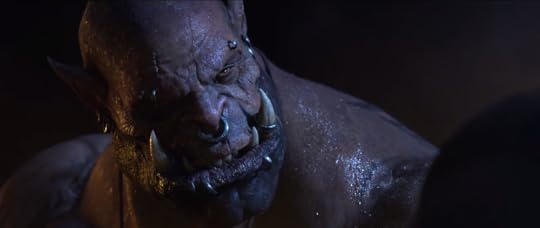
Garrosh, the son
Garrosh Hellscream is a charater who has been kicking around the WARCRAFT universe for several years now, first introduced as a callow and thoughtless youth, and then warrior. He rises in power, enough to challenge the current Warchief, Thrall. The challenge is rebuffed, but Garrosh is allowed to assume the mantle of Warchief when Thrall finds it necessary to abdicate. Garrosh proves himself a bloodthirsty and relentless leader, finally slipping into a self-manufactured insanity. He is removed from power, but escapes execution.
And slips back in time.
Now I know, I just lost you there, right? Because I felt the same way when I heard about the storyline for the soon-to-be-launched expansion to WORLD OF WARCRAFT. Seriously. I heard “going back in time” and “alternate timeline” and my eyes glazed over. I’d lost interest.
And then I watched the cinematic for the expansion and something hit me.
Here’s the video: https://www.youtube.com/watch?v=TLzhlsEFcVQ
For those of you who don’t watch it: at the moment that Grom Hellscream is about to trade freedom for power, he refuses. Then he attacks his would-be enslaver and kills him (the would-be enslaver being a demon named Mannoroth who is totally hella metal and why didn’t you just watch the video?). Then the son (from the future), Garrosh Hellscream saves his father’s life, both literally and metaphysically.
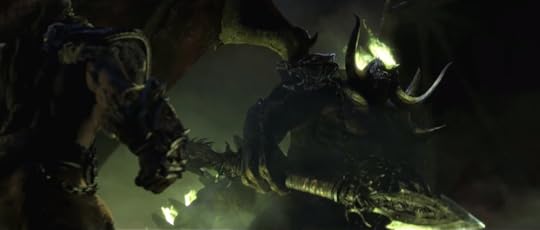
Mannoroth, the enslaver
Absolution. Because the sin didn’t happen. And what’s more, the presence of Garrosh gave Grom the strength to refuse the promise of easy power. Now, maybe I’m a sucker for this sort of thing. One of my favorite books is LORD KELVIN’S MACHINE by James Blaylock, wherein the titular hero uses a time machine, not to go back and kill the villain (who has killed his wife in the present), but to go back and change the villain’s life in such a way that he never even becomes the villain.
This is ultimate fantasy fiction, right? Something that can’t happen. It would be like LORD OF THE RINGS being about Frodo’s quest to not only destroy the ring and Sauron, but to make it so that Sauron never becomes a threat, and maybe, just maybe, becomes a hero in the work. Granted, that’s not going to happen because Sauron by design is evil and bad and has no reason for doing it, not even envy. He’s just bad.
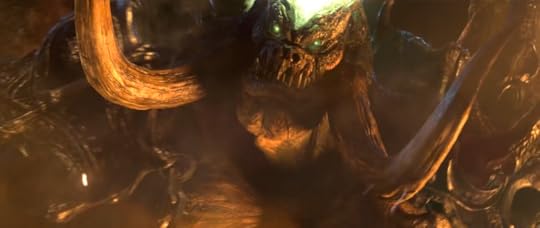
All the way bad
Garrosh Hellscream is bad because he’s human. Because he wants more than he can hold and is desperate to prove himself by strength and savagery. He’s human because he wants to undo that which has already happened and force history along another path. And he’s human because he wants to see his father succeed, to have the event that broke him never happen.
This also makes him a more interesting character than just about any that has been featured as a central player in the larger WORLD OF WARCRAFT plots. Garrosh has been allowed to make horrible, titanic mistakes (too many to name here), but he’s also striven to change them in a way that could only happen in fiction. About the only way that the developers (which is how I’ll refer to the creators of these authorless narratives) could have improved on this in my mind is to have Garrosh escape into the present and live with the mistakes that he’s made and try to build a better world from them (likely impossible, but this is fantasy fiction we’re talking about, so anything could be possible.)
It’s a real pity that these guys are all going to end up being the villains of the next couple years of WORLD OF WARCRAFT, because they’ve just been made more compelling for all of their mistakes.
On the technical side, the cinematics are beautiful as I’ve come to expect from the Blizzard Cinematics team and are every bit as good as what comes at us from Hollywood, backed up by their own aesthetic (which is extra metal this time around, and that’s fine by me.)
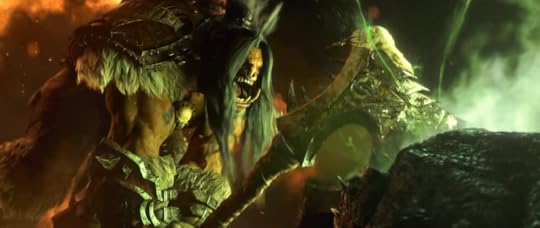
Hella metal.
Full disclosure: I’ve worked as a contractor for Blizzard Entertainment in 2010-2014. They’ve published one of my short stories, “The Teacher.” And I interviewed for a position on their cinematics team in 1999 or so. So I’m just a big suck-up, right?
September 15, 2014
Book fear
Here’s a 270 degree panorama of my office. Why am I posting this? Because in the near future I’m going to need to pack all of this up and move it out so the flooring can be redone here (as is going to happen in the rest of the house, apparently.) This thought terrifies me, and I’m sure you can figure out why from the pictures. You can’t even see the second table really, or the guitar amp and effects or the junk under my desk.
This process may indeed kill me. Or I may pack up all of my books and then get around to unpacking them and just saying “Nah.” Which I guess wouldn’t be the worst thing in the world, but doesn’t sound appealing now. I dunno. I’ve been collecting these things for a long damn time, and still can’t resist a trip to a used bookstore for a book about X-raying the Pharaohs or any period book on Los Angeles or a slightly better copy of LO! And I’ve been buying comics trades since they were just paperback collections of comics. Funny thing about that is most of those that I have now are basically valueless, with maybe the exception of the SANDMAN first edition collections. Otherwise, c’mon, who pays money for reprint comics.
Have fun poring over the book titles on the shelves. Had a pretty good time amassing them.
September 13, 2014
Lizard update
Bit of a scare yesterday. Was going to take Doc Connors in for a routine weighing (his low was 4.7 grams at his worst point, which is not far from skin and bones) when my son called me over to take a look at him. The lower part of his belly was a mess of purple veins and yellow-orange masses just below the skin. Gonna be honest. My heart dropped right out of my chest. It’d been a long struggle to get him stabilized and eating again and I really wasn’t ready to be told that it was time to pack it in.
But I took him to the vet anyways.
Turns out that he’s fine. The swelling in his liver has gone down (not much, but some) which means that his body is beginning to process all the fat that accumulated there. He’s also putting on weight, up to 7.1 grams now, which is still lower than when we bought him (somewhere near 9 grams), but far better than the lows when we thought he was going to need to be put down. The shocking visuals were courtesy his innards starting up work after a period of very low activity if not inactivity. The orange masses were small fat pads that are beginning to build up (as well as at the base of his tail, which is where geckos normally store fat.)
So it’s more or less back to normal. The worst is past, but there’s still no clarity as to whether the liver swelling will affect him long-term. Just a matter of keeping him fed and hydrated and more activity to help burn off or redistribute the fat that’s left in his system. Then figuring out what can be done to get him some more exercise. He seems to like exploring outside of his tank, but that’s not a viable option. Maybe a gecko obstacle course or something.
Highway 62 on Goodreads
Desert blacktop, too much caffeine, too little sl Simple repeater on Goodreads. Please for the love of all that is holy, read it on my site itself as Goodreads is incapable of even basic functionality.
Desert blacktop, too much caffeine, too little sleep, science fiction, fantasy, horror, film, music, pop culture debris. ...more
- Matt Maxwell's profile
- 23 followers


